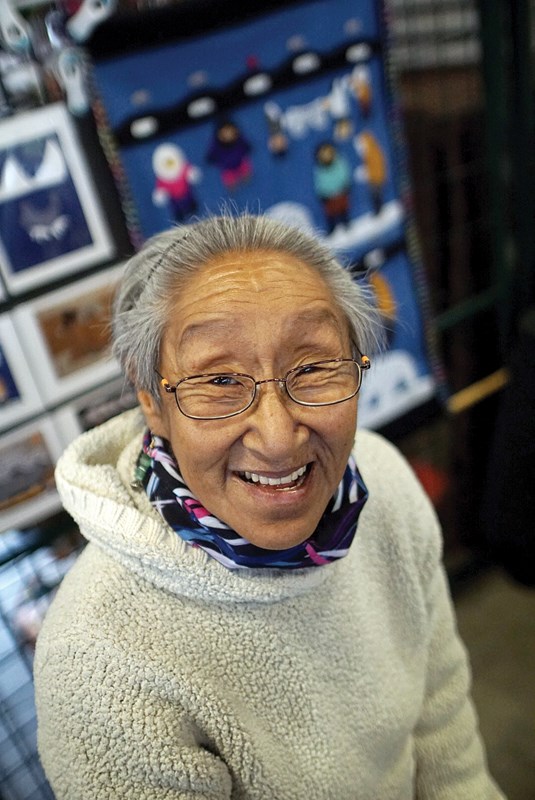A diminutive Annie Aculiak smiles proudly, her colourful felt tapestry on display in front of her during the bustling Shipyards Night Market.
All around Aculiak there are vendors selling their artisanal wares: handmade jewelry, leather handbags, baked goods, for instance. For some it’s a hobby, but for Aculiak, it’s her birthright.
Aculiak was born a twin in a melting igloo in a northern Inuit village on the Hudson Bay in 1958. Her twin brother did not survive. She is considered one of the last Canadian Eskimos to be born in an igloo.
Scenes from Aculiak’s childhood in the Artic, depicted through her colourful felt artwork, camouflage the pain.
“That’s me and that’s my brother,” says Aculiak, with an infectious giggle.
She’s pointing to a scene of her siblings bundled up in the snow, only their smiling faces showing. Behind them is a polar bear sniffing around an igloo.
“It makes me happy,” says Aculiak, looking at the art.
Aculiak was less than four years old when her mother taught her how to make needles from caribou bone and craft clothing from seal skin as well as wolf and bear hides. Her days, meanwhile, were spent fishing alongside her father for survival.
That family bonding was short-lived for Aculiak, who was taken from her father’s camp at the age of four and placed in a residential school in Port Harrison, where she suffered physical and mental abuse. Her seal skin clothing prompted teasing from her teachers and classmates.
After Aculiak developed tuberculosis at age of 10 she returned home to her family, having never learned to read or write at the residential school. She later married and had five children, four of whom died under tragic circumstances.
In 1998, Aculiak was lured to Vancouver with a promise of a better life but ended up on the Downtown Eastside, where she was rescued by a street outreach worker named Pierre Jacques.
It was only then that Aculiak could finally relax and dedicate her days to preserving a dying art form, which dates back approximately 300 years.
“The elders like Annie, they could teach … but (the younger generation) are not much interested in that anymore. So the art is being lost,” says Jacques of traditional Inuit tapestry.
It takes Aculiak four days to create one felt tapestry, starting with a memory. The stories of her early life and cultural upbringing are woven into in the art. She draws the scene and then cuts the felt materials and pieces them together like a puzzle onto the paper.
Aculiak’s art graces Buckingham Palace, Rideau Hall and the B.C. legislature, among other places around the world.
Locally, Aculiak, who now lives on the Sunshine Coast, will be selling her art all summer inside Lonsdale Quay Market on Saturdays, at the Shipyards Market on Friday evenings and at Ambleside Artisan Farmers’ Market on Sundays.
Aculiak’s framed original felt tapestry ranges from $325-350, while card prints of her artwork cost $5.



